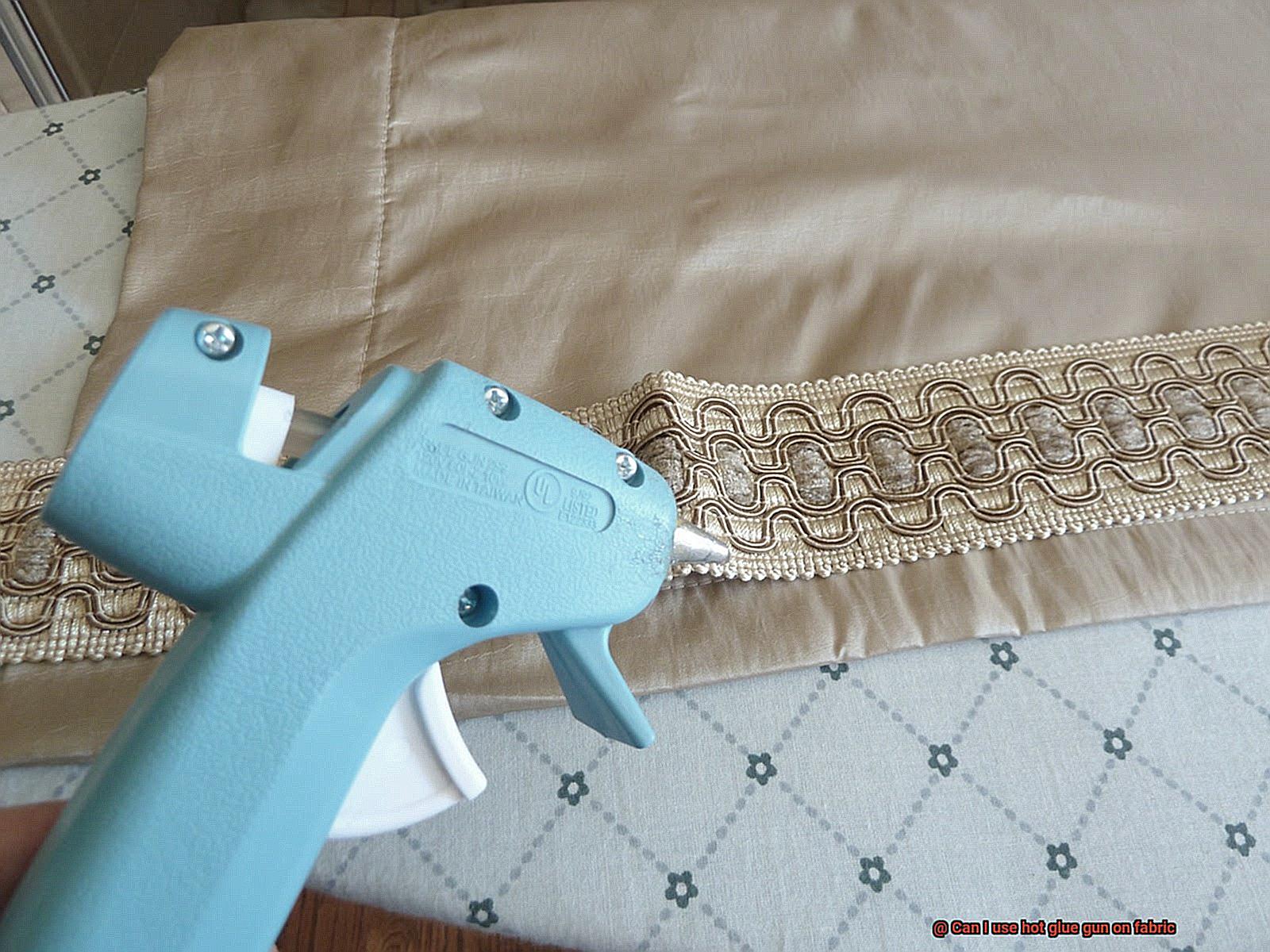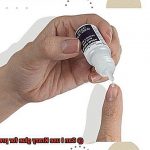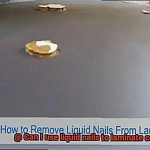Are you a crafty individual who loves to add some pizzazz to your fabric projects?
Or maybe you’re just itching to try out new techniques and get your creative juices flowing. Regardless, if you’re wondering whether a hot glue gun is the secret weapon for gluing fabric, look no further.
This blog post is your ultimate guide to the ins and outs of using a hot glue gun on fabric. We’ll dive deep into the perks and pitfalls, so you can make an informed decision.
So grab yourself a steaming cup of coffee, kick back, and let’s embark on this exciting journey into the world of fabric and hot glue guns.
Types of Fabric Suitable for Hot Glue
Contents
Synthetic fabrics like polyester, nylon, and acrylic are compatible with hot glue. These fabrics have a higher melting point and can withstand the heat from the glue gun without getting damaged. They also have smooth surfaces that provide a good surface for the glue to adhere to.
When using hot glue on synthetic fabrics, it is important to use a low temperature setting on the glue gun to prevent overheating and melting of the fabric. It is also advisable to apply the glue in small dots or lines rather than spreading it across a large area to prevent excessive heat build-up.
Cotton and Cotton Blends:
Cotton can be used with hot glue, but caution is required. It has a lower melting point compared to synthetic fabrics, so it’s important to use a low temperature setting on the glue gun and apply the glue in small amounts to avoid damaging the fabric.
When using hot glue on cotton, it is recommended to fold the fabric over onto itself while the glue is still hot to create a strong bond. This technique helps distribute the heat and prevents the glue from seeping through the fabric.
Denim:
Denim is a sturdy fabric that can withstand the heat from hot glue. Its rough texture provides a good surface for the glue to grip onto, making it an ideal fabric for hot glue projects.
When using hot glue on denim, it is important to apply the glue evenly and press firmly to ensure a strong bond. It is also recommended to use a low temperature setting on the glue gun to prevent any damage to the fabric.
Felt:
Felt is an excellent fabric for hot glue applications. It is thick and dense, which makes it easy for the glue to adhere to. Felt is often used in craft projects such as making felt flowers or ornaments using hot glue.
When using hot glue on felt, it is important to apply the glue in small dots or lines and press firmly to ensure a secure bond. It is also advisable to use a low temperature setting on the glue gun to prevent any damage to the fabric.
Silk and Satin:
Silk and satin are delicate fabrics that require extra care when using hot glue. The high heat from the glue gun can easily damage these fabrics, so it’s important to use a low temperature setting and apply the glue sparingly.
When using hot glue on silk or satin, it is recommended to test a small, inconspicuous area of the fabric first to ensure that it does not discolor or warp under the heat. It is also advisable to apply the glue in small dots or lines rather than spreading it across a large area to prevent excessive heat build-up.
Precautions when using Hot Glue on Fabric:
- Test a small, inconspicuous area of the fabric before applying hot glue to the entire project.
- Use low temperature settings on the glue gun to prevent damaging delicate fabrics.
In conclusion, when using hot glue on fabric, it is important to choose the right type of fabric that can withstand the heat and adhere well to the glue. Synthetic fabrics, cotton and cotton blends, denim, felt, and certain upholstery fabrics are suitable for hot glue. Delicate fabrics such as silk and satin require extra caution, and fabrics with embellishments may not be suitable for hot glue.
Testing Hot Glue on Fabric
Testing hot glue on fabric is a crucial step to ensure a strong bond without any unwanted consequences. Whether you are working on a craft project or repairing a fabric item, it is essential to determine how well the hot glue will adhere and if it will cause any damage or discoloration. To help you with this process, here is a comprehensive step-by-step guide:
- Choose a scrap piece of fabric: Select a small piece of fabric that closely resembles the composition and texture of the fabric you will be using for your project. This will give you a more accurate understanding of how the hot glue will interact with your desired material.
- Clean the fabric: Before testing the hot glue, make sure to clean the surface of the fabric to remove any dirt, dust, or oils that may hinder the adhesion process. Use a mild detergent to gently wash or wipe the fabric, ensuring a clean surface for testing.
- Heat up your hot glue gun: Follow the instructions provided by the manufacturer to heat up your hot glue gun. It is crucial to use a low-temperature setting to avoid damaging or melting the fabric fibers.
- Apply a small dab of hot glue: Carefully apply a small amount of hot glue onto the scrap fabric. Be cautious not to use excessive glue, as it may seep through the fabric or create a bulky appearance.
- Press fabrics together: Immediately after applying the hot glue, press another piece of fabric firmly onto it. Hold it in place for a few seconds to allow the glue to set properly.
- Inspect the bond: Once the glue has cooled and set, inspect the bond between the two pieces of fabric. Look for any signs of peeling, lifting, or weak adhesion. Also, check if there is any discoloration or damage caused by the glue.
- Repeat with different fabrics: If you plan to use hot glue on various types of fabrics, repeat the testing process with each one individually. Different fabrics may react differently to hot glue, so it is crucial to test each fabric separately.
- Evaluate the results: Based on your observations, evaluate whether the hot glue adheres well and does not cause any damage or discoloration to the fabric. If the results are satisfactory, you can proceed with confidence in using hot glue for your project. However, if the glue does not bond securely or causes negative effects on the fabric, consider exploring alternative adhesive options specifically designed for fabric, such as fabric glue or fusible webbing.
It is important to note that hot glue may not be suitable for all fabric types, especially delicate or heat-sensitive materials. In such cases, it is advisable to consult with a professional or explore alternative methods of attaching or embellishing fabric.
Applying Hot Glue to Fabric
Applying hot glue to fabric requires careful attention to detail and adherence to certain guidelines. By following these steps, you can confidently create beautiful, durable projects without any unexpected mishaps.
Firstly, it is crucial to test a small, inconspicuous area of the fabric before applying hot glue. This will help determine if the glue will damage or discolor the fabric. Apply a small amount of glue and let it dry before proceeding.
Choosing the right type of hot glue is also important. Opt for a fabric-specific hot glue, as they are designed to bond fabric and offer greater flexibility and durability compared to regular hot glue.
When using a standard hot glue gun, set the temperature on low or medium to prevent the glue from becoming too hot and potentially damaging the fabric. Always follow the manufacturer’s instructions for your specific glue gun.
To ensure an even and thin application of hot glue, start by applying a small amount and spread it out using a toothpick or a craft stick. This will help avoid creating bulky or stiff areas on the fabric.
Protect your work surface by placing wax paper or a silicone baking mat underneath the fabric. This will prevent the hot glue from seeping through and sticking to your work surface, making cleanup easier.
After joining the fabric pieces together with hot glue, apply pressure for a strong bond. You can use clamps or place a heavy object on top of the glued area until the glue dries. This will help ensure that the fabric pieces stay securely in place.
Patience is key when it comes to hot glue and fabric. Allow the hot glue to fully dry and set before handling or wearing the fabric. This typically takes around 24 hours, but drying times may vary depending on the type of glue used and environmental conditions.
If you notice any excess hot glue visible on the fabric after application, carefully remove it by gently peeling or cutting it off. Be cautious not to damage or fray the fabric in the process.
While hot glue can be used on various types of fabrics, it’s important to consider fabric suitability. Delicate or heat-sensitive fabrics may not be suitable for hot glue, and alternative methods like sewing or using fabric-specific adhesives may be more appropriate.
Finally, store your hot glue gun and glue sticks properly to maintain their quality. Turn off and unplug the glue gun after use, and store the glue sticks in a cool and dry place.
Folding the Fabric Over onto Itself
Crafting with fabric often involves folding it over onto itself, a technique that creates clean edges and a neat finish. However, when using a hot glue gun on fabric, this process can present challenges. To overcome them and achieve professional results, consider the following tips:
- Choose the right fabric: Lightweight or delicate fabrics may be prone to damage or show marks when exposed to the heat of the glue. Opt for thicker, sturdier fabrics like denim or canvas for better results.
- Prevent seepage: Applying excessive amounts of glue when folding fabric can cause seepage. To avoid this, use a small amount of glue along the edge of the fabric. This minimizes the risk of glue seeping through the layers and creating unsightly marks.
- Reinforce with stitching: For added stability, reinforce the folded edge with stitching. Sewing a straight stitch along the folded edge secures it in place and creates a stronger bond.
- Test on scrap fabric: Each fabric and hot glue gun combination can yield different results, so it’s crucial to test on scrap fabric before applying glue to your project. Experiment with different techniques and materials to find what works best.
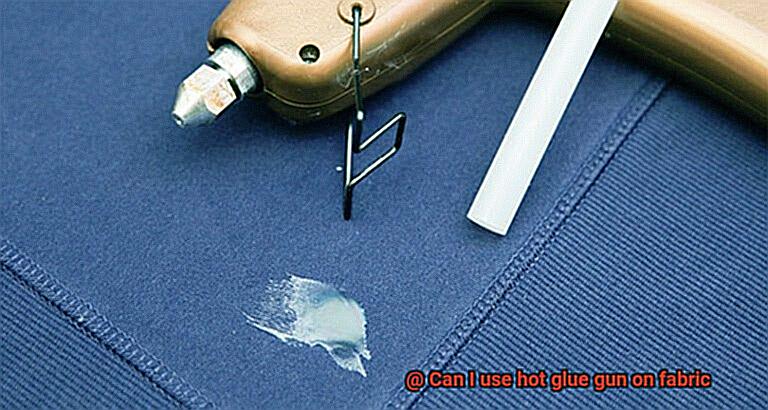
Removing Hot Glue from Fabric
Crafting with fabric can be a delicate and intricate process, but accidents happen. If you find yourself with hot glue on your fabric, don’t panic. There are several methods you can use to effectively remove hot glue from fabric without causing damage. Let’s explore these techniques:
- Freezing Method: Place the fabric with the glued area in a plastic bag and put it in the freezer for a few hours. Once the glue hardens, gently scrape it off with a dull knife or your fingernail. Be careful not to pull or tug on the fabric too much to avoid causing any damage.
- Heat Method: Place a clean cloth or paper towel over the glued area and apply heat using an iron on a low setting. The heat will melt the glue, and the cloth or paper towel will absorb it. Continue repeating this process until all the glue is removed.
- Rubbing Alcohol: Apply a small amount of rubbing alcohol to a clean cloth and gently dab at the stained area. The rubbing alcohol will help dissolve the glue, making it easier to remove. Be cautious as rubbing alcohol can potentially damage certain fabrics, so it’s essential to test it on a small, inconspicuous area first.
- Acetone: Apply a small amount of acetone to a clean cloth and gently dab at the stained area. Acetone is effective in removing hot glue, but it can also damage certain fabrics, so it’s important to test it on a small area first.
- Adhesive Removers: For delicate fabrics that may be sensitive to heat or chemicals, using an adhesive remover specifically designed for removing glue stains from fabric is recommended. These products are available in most craft stores or online. Follow the instructions provided on the product’s packaging for best results.
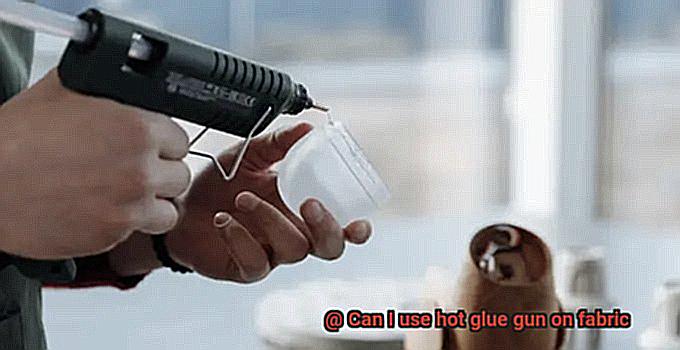
Remember, prevention is always better than having to remove hot glue from fabric. When working with a hot glue gun, take precautions such as using a protective barrier like wax paper or parchment paper between the fabric and the glue gun’s nozzle. This way, even if some glue accidentally gets on the fabric, it will be easier to remove.
Durability of Hot Glue on Fabric
The durability of hot glue on fabric is influenced by several key factors, making it crucial to consider these elements when using this adhesive.
Firstly, surface preparation is vital for a strong bond. Cleaning the fabric and removing any dirt, oils, or finishes that may hinder adhesion is recommended. Gently washing the fabric or using a mild detergent can eliminate residue, while lightly roughening the surface with sandpaper can enhance the glue’s grip.
Another factor to consider is the drying time of hot glue. To ensure maximum durability, it is essential to allow the glue to cool and cure fully before subjecting it to any stress or movement. This process typically takes around 30 seconds to a minute, but variations may occur depending on glue thickness and temperature.
Furthermore, certain fabrics may not be compatible with hot glue due to their delicate fibers. Fabrics like silk or lace are more susceptible to heat damage from hot glue guns. In such cases, alternative methods such as fabric adhesives or hand sewing should be considered.
Proper care and maintenance also impact the durability of fabric bonded with hot glue. Following manufacturer instructions for washing and handling can prolong the bond’s lifespan. Avoiding excessive heat or harsh chemicals during cleaning prevents deterioration of the hot glue.
Alternative Methods for Bonding Fabrics
When it comes to bonding fabrics, hot glue guns may be the go-to choice for many crafters, but they aren’t always the best option. Luckily, there are alternative methods available that can offer a stronger and more durable bond. Let’s explore some of these options in detail.
Fabric glue is a popular alternative to hot glue guns. It is specifically designed to bond fabrics together, providing a strong and permanent hold. Available in liquid form, fabric glue can be easily applied using a brush or nozzle. What makes fabric glue so appealing is its ability to withstand washing and dry cleaning, making it an ideal choice for fabric bonding projects.
Another option to consider is fusible webbing. This thin adhesive material is activated by heat and comes in sheets or rolls. By cutting it to size and placing it between two layers of fabric, you can create a seamless bond by applying heat with an iron. Fusible webbing is commonly used for hemming, appliqué work, and patching fabrics.
Of course, sewing remains a traditional method of bonding fabrics together. While it may require more time and effort compared to using adhesives, sewing offers a strong and secure bond. Whether you choose hand stitching, machine stitching, or zigzag stitching, sewing not only creates a durable bond but also allows for flexibility and movement in the fabric.
For those who prefer a no-sew option, fabric tapes can be a convenient choice. These adhesive strips or sheets can be applied directly to the fabric to create a bond. Available in different widths and lengths, fabric tapes are suitable for various fabric bonding needs. They offer both temporary and permanent holds depending on the specific product.
Lastly, there are specialty adhesives available specifically for fabric bonding. These adhesives are formulated to provide a strong bond while remaining flexible and washable. Fabric spray adhesives, fabric glues with added flexibility, and fabric adhesives designed for stretchy fabrics are just a few examples. These specialty adhesives are perfect for projects that require extra durability or flexibility.
Precautions When Using Hot Glue on Fabric
When using hot glue on fabric, it is crucial to take certain precautions to achieve the best results and avoid any damage to the fabric. Here are some important precautions to keep in mind to ensure a successful and safe bonding process:
- Temperature setting: Most hot glue guns come with different temperature settings. When working with fabric, it is generally recommended to use a lower temperature setting. This helps prevent scorching or melting of the fabric.
- Test on a small area: Before applying hot glue to a larger surface of the fabric, it is essential to perform a test on a small, inconspicuous area first. This allows you to observe how the fabric reacts to the glue and make any necessary adjustments before committing to the project.
- Avoid using excessive glue: Applying too much glue can result in a messy and bulky appearance, as well as make the fabric stiff and less flexible. To ensure a secure bond without compromising flexibility, it is best to apply a thin, even layer of glue.
- Work quickly: Hot glue dries rapidly, so it is important to work quickly and efficiently. Apply the glue and bond the fabric together as soon as possible to avoid misalignment or uneven bonding that may occur if the glue starts setting before you are ready.
- Use tools, not fingers: Directly touching hot glue with your fingers should be avoided. The high temperatures can cause burns. Instead, use tools like tweezers or popsicle sticks to handle the glue and apply it onto the fabric.
- Ventilation: Proper ventilation is crucial when using hot glue on fabric. The fumes emitted by hot glue can be irritating and potentially harmful if inhaled in large quantities. Working in a well-ventilated area or using a small fan to circulate air can help minimize exposure to these fumes.
- Store safely: After using a hot glue gun, always unplug it and allow it to cool down completely before storing. This prevents accidents or injuries that may occur if the hot glue gun is left unattended or improperly stored.
Conclusion
Yes, you can definitely use a hot glue gun on fabric.
It’s a quick and easy way to adhere different materials together without the need for sewing or stitching. The hot glue gun melts the adhesive sticks, allowing you to apply it directly onto the fabric.
With a steady hand and some practice, you’ll be able to create secure bonds that will hold up well over time.

